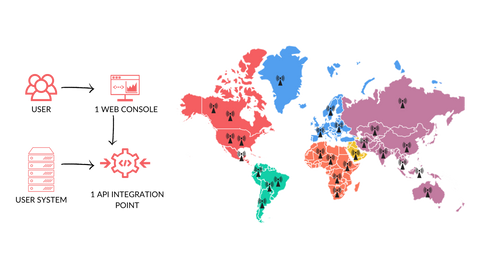
Comprehensive Guide For Telematics & Its Benefits
Telematics is used to keep track of a variety of telemetry data about a single device/ sensor or a fleet as a whole. While the automobile industry is the primary user of telematics, other industries have also found applications for it. Telematics has transformed a variety of businesses in recent years, particularly the transportation, construction, and excavation sectors. The adoption of telematics by businesses operating fleets of vehicles across a wide range of industries has aided in boosting customer service standards, reliability, and efficiency.
What is telematics?
The terminology is a combination of two concepts, namely, “telecommunication” and “infomatics”. It represents the integrated use of communications and information technologies to transmit, save and receive information from devices remotely in real-time.
How does telematics work?
Local devices and sensors collect data about the location of vehicles, driver behavior, engine diagnostics, and vehicle activity. This data is then sent to the cloud for visualization and analytics to assist fleet operators in managing their resources and assets more efficiently.
How do fleets use telematics systems?

Fleet telematics systems allow data to be transferred to a centralized location and specific vehicles within the fleet, which may include trucks, ambulances, city cars, school buses, and other types of vehicles.
Information is transmitted to and from a vehicle's computerized systems. Services like GPS navigation, roadside support, remote diagnostics, and fleet management are made possible.
Benefits of telematics for fleet management
Telematics has recently become a crucial component of fleet management due to its versatility in boosting vehicle tracking systems. The following is possible but this is not an exhaustive list:

- Location tracking
- Geofencing
- Vehicle speed monitoring
- Incidents involving vehicles
- Diagnostics for vehicles (e.g. EPM, MPG, odometer)
- Vehicle status
- Remote vehicle inspection
- Panic alerts
- Dispatching jobs and messaging
- Sensor or electrical activity (via PTO)
- Video from the dashboard camera
Additionally, telematics systems combine driver performance with vehicle routing and maintenance planning to offer a thorough and all-encompassing solution to fleet management's core problems. It, therefore, goes well beyond just vehicle tracking. Improved fleet visibility makes it easier to assess the resources and usage of a fleet. The fleet tracking system's near real-time fleet analytics combined with customizable dashboards can make it simple to assess the progress toward KPIs or budgets. The long-term benefits of better fleet management are well worth the investment, including the ability to unearth hidden expenses and the potential for increased productivity and efficiency across the board.
How are telematics devices installed?
Many contemporary commercial vehicle manufacturers directly integrate telematics systems into their vehicles. If a car does not already have this technology installed, aftermarket units can be installed. These can be powered by batteries or the car's internal electrical system. A small telematics device, often known as a black box, is plugged into the vehicle's OBD II or CAN-BUS port and records data from it to track assets. Communication on the cellular network is made possible by a SIM card and modem inside the device.
The future of telematics
To offer a smooth end-user experience, certain OEMs, including Volvo, Mack, Hino, Ford, and GM, also collaborate with telematics providers. In the upcoming years, it's expected that the automobile industry will continue to create smart cars that employ telematics to provide better services for consumers. There isn't much that transportation businesses can do about lockdowns, chip shortages, or a troubled global economy. However, using AI to improve fleets' reliability is the key to the future of telematics. Fleet telematics systems may connect cars to cities and smart traffic systems in the near future.
Connecting Telematics Devices
Fleets may require several sensors from various sources, necessitating multiple gateways on various networks, to get a complete picture of a single vehicle. The industry largely depends on cellular connectivity and choosing the right connectivity option is of paramount importance.
This is where ConnectedYou can help in providing the optimal network for continued connectivity.
Why ConnectedYou?

Our connectivity solution is universally independent of any connectivity provider. Choose from 40+ pre-integrated connectivity suppliers with a global roaming footprint based on your connectivity requirements across different regions.
We orchestrate the critical components that include - eUICC-enabled SIMs/ eSIMs, global IoT/ M2M connectivity, unified monitoring & management, and remote SIM provisioning capabilities into a single solution as a one-stop-shop. Here’s why our product is the best solution for your enterprise -
- The largest network of 2G, 3G, 4G, 5G, LTE-M, and NB-IoT networks
- Connectivity for countries with permanent roaming restrictions
- Transparent Pay-As-You-Go pricing without hidden charges or minimum commitments
- Single contract enabling hassle-free multi-supplier sourcing without lock-ins with any connectivity provider
- Unified platform to manage your IoT/ M2M SIM cards irrespective of the connectivity supplier
- Capability to switch connectivity suppliers remotely without SIM replacement and without any additional transaction costs
- Central support desk for all connectivity issues
Get in touch with us to understand more about how we can help to enable telematics devices and we would be happy to help!
Written by - Neha Verma and Parag Mittal
